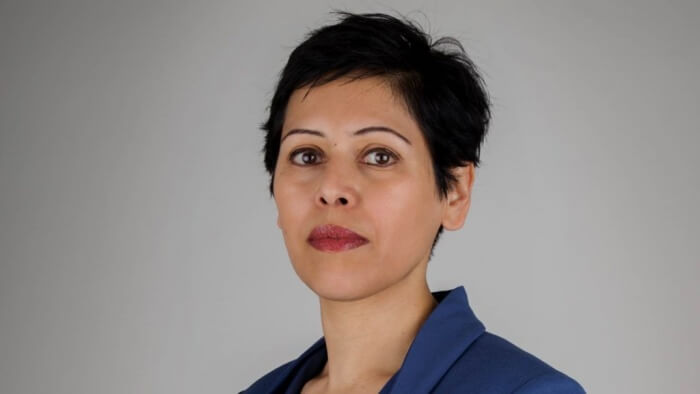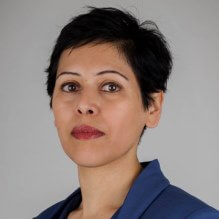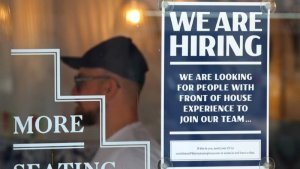Heidy Rehman's fashion house Rose & Willard was inspired by a perceived lack of sartorial options for professional women. Here she describes the rocky road that connects having an idea and establishing a good business.
Trading Places: From Citi Group To Start-Up
Heidy Rehman's fashion house Rose & Willard was inspired by a perceived lack of sartorial options for professional women. Here she describes the rocky road that connects having an idea and establishing a good business.

For more than 14 years, I worked in London and then Dubai, climbing the corporate ladder as a stockbroker - or more specifically, an equity research analyst - at one of the largest investment banks in the world, Citi.
And then 18 months ago I gave it all up to launch my own business, an ethical fashion house called Rose & Willard. A radical move, some might say. And many have asked why I made this decision.
I was at a point where a choice was becoming inevitable. Every analyst chases and covets the illustrious top ranking of the two main City surveys, as voted by investors globally. I was top ranked in both surveys and across two sectors.
Professionally, I’d arrived but knew I needed to make a decision. Should I fight to retain my titles, change sectors again, opt for an upward but more managerial, administrative route or should I try something new?
The gender conundrum
This crossroad coincided with me evaluating my place as a woman within the vastly male-dominated arena of investment banking.
I had always felt that women had to do that much more to prove themselves. I began to think more seriously about the perception of women in the professional working world. What I undoubtedly knew was that this would play a huge part in whatever path I chose.
How we present ourselves can influence a person’s entire opinion of us. For women, who are judged much more readily on their appearance, this is all the more important, especially when it is mostly the positive opinion of men in positions of power that we seek.
What I began to realise was that women lacked choice when it came to personal presentation or, more specifically, there were insufficient wardrobe options for professional women. I’d struggled with this myself. While I did well enough I didn’t have a luxury budget and high street wasn’t a genuine option; it was aimed predominantly at a younger market and, to me, also represented an ethical compromise.
Being a professional woman I was aware that I needed to pay close attention to what I wore but not so much as to be considered frivolous or superficial. I needed to be readily identified as distinct from the secretaries but not to appear too concerned with my appearance. There was no easy or ready answer.
"Nothing is as rewarding as creating something of your own and seeing it come to life"
Speaking to a few of my female peers I found they also struggled with the same issue. My conclusion, as an analyst, was that there was a gap in the market.
But who to fill it? Gradually I started to think, why not me? I’d had the benefit of some very good advice in my life; someone had once said to me ‘don’t be afraid of change’ and this had spurred my move to Dubai, away from almost all that was familiar, but one that had worked out very well. And, in all seriousness, other people had done it so why couldn’t I. And so I did.
Tying it all together
The first thing I did was to do what I was used to doing – gathering information about what I needed to know. I read books, poured over industry articles and CEO interviews, making notes of what needed to be done. There had to be a formula, or so I thought – incorporate a company, register a trademark, hire people, buy some fabric, contract with factories to manufacture some products and market them.
What I hadn’t anticipated was the reality of tying it all together and with people in between. It dawned on me very quickly that analysing companies is one thing, starting and running them is a whole other ball game.
The first part was easy – an online application to Companies House and Endeavour Clothing Ltd was born. What I hadn’t anticipated was the lawyers telling me that NASA had the rights to all things Endeavour. I needed a new name, one that not only captured the essence of the brand but also one that no one else had considered. It took some time but Rose & Willard (which means feminine and bold) finally surfaced and was perfect.
Aware that I was no fashion designer, I knew I needed one. And where else to find one than London’s Central Saint Martin’s. Adverts went out, applications came flooding in and the interviews started.
What I needed was someone who could creatively translate my commercial vision into reality. The problem I faced was that most candidates simply saw me as a funding tool for their own aesthetic vision.
And I didn’t just need a designer, I needed a pattern cutter. Researching and reading about these roles had seemed simple enough but what I didn’t understand was how I could test them at interview. I also realised that I needed to acquire and understand a whole new industry vocabulary. For the first time in a long time, I was lacking experience.
After finally relocating permanently from Dubai to London I believed I could properly focus and slot the various pieces into their respective places.
I was fortunate to find a good studio with plenty of natural light and started ordering in equipment. I then busied myself securing qualified, dedicated and capable staff, all hungry for the opportunity.
Understanding the practical implementation and realistic timetable of a critical path was another unfamiliar territory for me. The pattern cutting took far too long. The ordering of our fabric choices was also hindered by our lack of scale versus the required minimum ordering thresholds imposed by a number of mills.
And then there were the factories; aside from finding those we thought could deliver the appropriate quality, our order quantities again were often too low.
It was a new reality for me; coming from a place where requesting a meeting with the CEO of a multinational organisation had posed no problem to liaising with much smaller factories and mills for whom we were of little or no significance.
A start-up with a corporate culture
My familiarity with the clear demarcated lines of corporate culture inspired me to impose a high level of professionalism throughout my team and the way it worked. We would have structure, responsibility and accountability. No timetable, no cost and no task could be open-ended.
Interestingly this didn’t transform me into some kind of dictator. Rather the team responded positively. They actually valued the limits of the parameters within which they were now expected to operate. My belief that creative people respected and needed fluidity in their work has now been somewhat redrawn. Many react equally positively to a more formal framework.
Progressively the team was coming together. And for any new team member I decided to break with the traditional hiring approach. Working in the City I had seen first hand how the privilege of class and the networking opportunities that offers can propel a person’s career.
To my surprise I saw this reflected in the fashion industry where, interestingly, there is also a snobbery attached to luxury versus high street experience.
In order to secure an initial footing on the professional ladder any graduate’s CV needs to include internships and at the correct establishments. The challenge for most aspiring, fashion-related graduates is that internships were, and to a large degree still are, unpaid. Indeed some do not even receive travel costs.
My working class background was certainly not one of privilege. Having my own company made me realise that I could either reinforce the status quo and take advantage of unpaid interns or change course. Despite the cost I opted for the latter.
I wanted to offer opportunities to people who could demonstrate sufficient ability and a strong appetite for the job regardless of their experience. This led me to hire people who no recruitment consultant would likely ever have suggested; and these have been the best hiring decisions I have made.
Standing out from the crowd
It has taken time but the foundations have now fallen into place. I take an active role in every aspect and process of the business. Our critical paths run to order, we have an established set of suppliers and manufacturers with options on others and operate strictly within our ethical boundaries.
What I also needed to master was the marketing side of the business equation. The British womenswear market is worth over £20bn per annum but is highly fragmented with even the largest players having less than 10% market share.
The challenge I faced was how to stand out from this very busy crowd, a crowd which included brands with budgets multiple times larger than mine. What I learned as an analyst was that it was futile to try to be better when my competition was already exceptional. I had to be not only the best that I could be but also different to avoid getting lost in the very large, and often very slick, womenswear market crowd.
In my search for the right PR firm I deliberately looked for something different. That is what I believe I have now found. A PR firm with an alternative approach, one which is open to any good idea and has proven to open doors for us that we may never have knocked upon.
So ultimately, while I have relied on my own resources, there are those of my team and the partners we have chosen that have set us on a path which I hope will be long and fruitful.
Nothing is as rewarding as creating something of your own and seeing it come to life. I recall a chat with a friend once about my trepidation at trekking alone around China. Her response had been ‘well, if you think like that you’ll never do anything’.
Thanks for signing up to Minutehack alerts.
Brilliant editorials heading your way soon.
Okay, Thanks!



